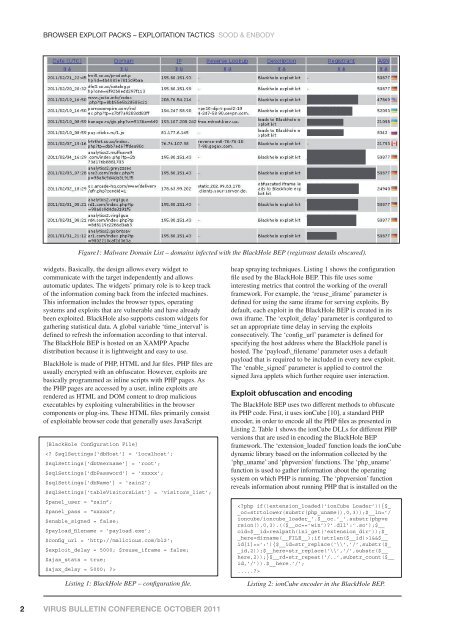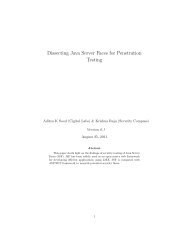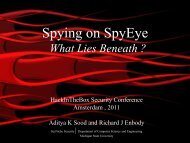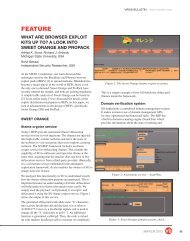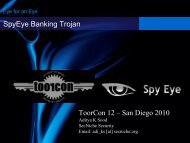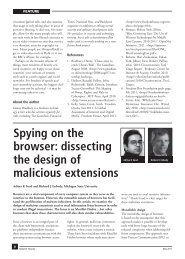browser exploit packs â exploitation tactics - SecNiche Security Labs
browser exploit packs â exploitation tactics - SecNiche Security Labs
browser exploit packs â exploitation tactics - SecNiche Security Labs
Create successful ePaper yourself
Turn your PDF publications into a flip-book with our unique Google optimized e-Paper software.
BROWSER EXPLOIT PACKS – EXPLOITATION TACTICS SOOD & ENBODY<br />
Figure1: Malware Domain List – domains infected with the BlackHole BEP (registrant details obscured).<br />
widgets. Basically, the design allows every widget to<br />
communicate with the target independently and allows<br />
automatic updates. The widgets’ primary role is to keep track<br />
of the information coming back from the infected machines.<br />
This information includes the <strong>browser</strong> types, operating<br />
systems and <strong>exploit</strong>s that are vulnerable and have already<br />
been <strong>exploit</strong>ed. BlackHole also supports custom widgets for<br />
gathering statistical data. A global variable ‘time_interval’ is<br />
defined to refresh the information according to that interval.<br />
The BlackHole BEP is hosted on an XAMPP Apache<br />
distribution because it is lightweight and easy to use.<br />
BlackHole is made of PHP, HTML and Jar files. PHP files are<br />
usually encrypted with an obfuscator. However, <strong>exploit</strong>s are<br />
basically programmed as inline scripts with PHP pages. As<br />
the PHP pages are accessed by a user, inline <strong>exploit</strong>s are<br />
rendered as HTML and DOM content to drop malicious<br />
executables by <strong>exploit</strong>ing vulnerabilities in the <strong>browser</strong><br />
components or plug-ins. These HTML files primarily consist<br />
of <strong>exploit</strong>able <strong>browser</strong> code that generally uses JavaScript<br />
[BlackHole Configuration File]<br />
<br />
Listing 1: BlackHole BEP – confi guration fi le.<br />
heap spraying techniques. Listing 1 shows the configuration<br />
file used by the BlackHole BEP. This file uses some<br />
interesting metrics that control the working of the overall<br />
framework. For example, the ‘reuse_iframe’ parameter is<br />
defined for using the same iframe for serving <strong>exploit</strong>s. By<br />
default, each <strong>exploit</strong> in the BlackHole BEP is created in its<br />
own iframe. The ‘<strong>exploit</strong>_delay’ parameter is configured to<br />
set an appropriate time delay in serving the <strong>exploit</strong>s<br />
consecutively. The ‘config_url’ parameter is defined for<br />
specifying the host address where the BlackHole panel is<br />
hosted. The ‘payload\_filename’ parameter uses a default<br />
payload that is required to be included in every new <strong>exploit</strong>.<br />
The ‘enable_signed’ parameter is applied to control the<br />
signed Java applets which further require user interaction.<br />
Exploit obfuscation and encoding<br />
The BlackHole BEP uses two different methods to obfuscate<br />
its PHP code. First, it uses ionCube [10], a standard PHP<br />
encoder, in order to encode all the PHP files as presented in<br />
Listing 2. Table 1 shows the ionCube DLLs for different PHP<br />
versions that are used in encoding the BlackHole BEP<br />
framework. The ‘extension_loaded’ function loads the ionCube<br />
dynamic library based on the information collected by the<br />
‘php_uname’ and ‘phpversion’ functions. The ‘php_uname’<br />
function is used to gather information about the operating<br />
system on which PHP is running. The ‘phpversion’ function<br />
reveals information about running PHP that is installed on the<br />
<br />
Listing 2: ionCube encoder in the BlackHole BEP.<br />
2 VIRUS BULLETIN CONFERENCE OCTOBER 2011


